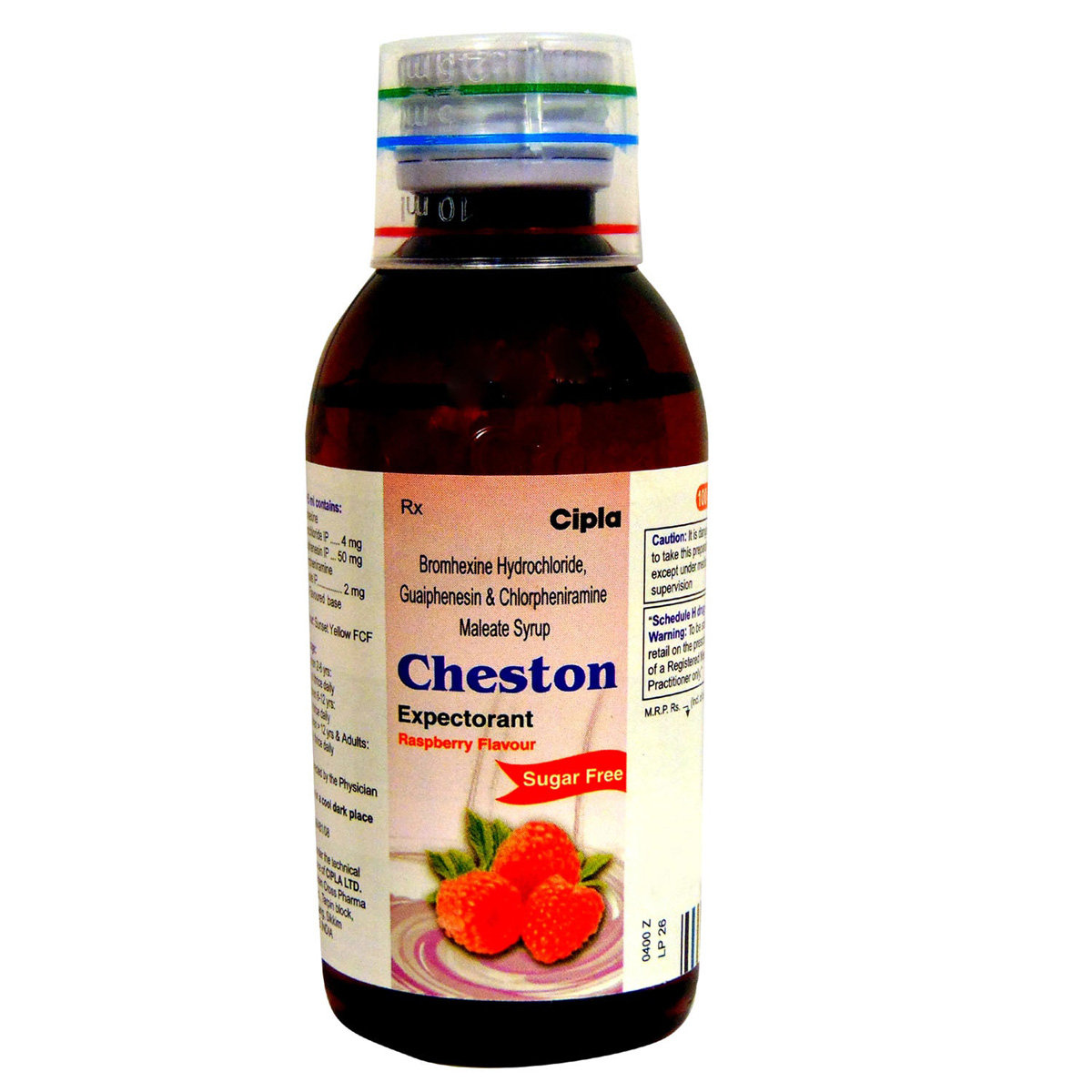Guaifenesin+bromhexine
About Guaifenesin+bromhexine
Guaifenesin+bromhexine belongs to the class of medicines called ‘expectorants’ primarily used to treat cough associated with mucus. Coughing (dry or productive) is a body’s way of clearing irritants (like allergens, mucus, or smoke) from airways and preventing infection. There are two types of coughs, namely: Dry cough and chesty cough. A dry cough is tickly and doesn't produce any vicious or thick mucus, while a chesty cough (wet cough) means mucous or sputum is produced to help clear your airways.
Guaifenesin+bromhexine is a combination of two drugs, namely: Guaifenesin (expectorant) and Bromhexine (mucolytic agent). Guaifenesin belongs to the class of expectorants that works by loosening the congestion in the chest and throat, making it easier to cough out through the mouth. On the other hand, Bromhexine belongs to the class of mucolytic agents (cough/sputum thinner) that works by thinning and loosening phlegm (mucus) in lungs, windpipe, and nasal passage thereby, helping to cough out easily.
Take Guaifenesin+bromhexine as prescribed. Your doctor will recommend how often you take Guaifenesin+bromhexine based on your medical condition. Some people may experience nausea, vomiting, drowsiness, headache, dizziness, skin rash, stomach upset, and diarrhoea. Most of these side effects of Guaifenesin+bromhexine do not require medical attention and gradually resolve over time. However, if the side effects persist or worsen, please consult your doctor.
If you are allergic to Guaifenesin+bromhexine or any other medicines, please tell your doctor. If you are pregnant or breastfeeding, it is advised to inform your doctor before using Guaifenesin+bromhexine. Guaifenesin+bromhexine should be used with caution in children below 6 years. Drink plenty of fluids while taking Guaifenesin+bromhexine to loosen mucus. If you have stomach ulcers, asthma, phenylketonuria (a congenital disability that causes accumulation of amino acid, or phenylalanine in the body), or kidney or liver problems, inform your doctor before taking Guaifenesin+bromhexine.
Uses of Guaifenesin+bromhexine
Medicinal Benefits
Guaifenesin+bromhexine is a combination of two drugs, namely: Guaifenesin (expectorant) and Bromhexine (mucolytic agent). Guaifenesin belongs to the class of expectorants that works by loosening the congestion in the chest and throat, making it easier to cough out through the mouth. On the other hand, Bromhexine belongs to the class of mucolytic agents (cough/sputum thinner) that works by thinning and loosening phlegm (mucus) in lungs, windpipe and nasal passage thereby, helping to cough out easily. Guaifenesin+bromhexine does not cough sedation or sleepiness like other codeine containing cough syrups.
Directions for Use
Storage
Side Effects of Guaifenesin+bromhexine
- Nausea
- Vomiting
- Drowsiness
- Headache
- Dizziness
- Skin rash
- Stomach upset
- Diarrhoea
Drug Warnings
If you are allergic to Guaifenesin+bromhexine or any other medicines, please tell your doctor. If you are pregnant or breastfeeding, it is advised to inform your doctor before using Guaifenesin+bromhexine. Guaifenesin+bromhexine should be used with caution in children below 6 years. Avoid using Guaifenesin+bromhexine if you are suffering from stomach ulcers as it may worsen the condition. Drink plenty of fluids while taking Guaifenesin+bromhexine to loosen mucus. If you have stomach ulcers, asthma, phenylketonuria (a birth defect that causes accumulation of amino acid, phenylalanine in the body), kidney or liver problems, inform your doctor before taking Guaifenesin+bromhexine.
Drug Interactions
Drug-Drug Interaction: No interactions found.
Drug-Food Interaction: No interactions found.
Drug-Disease Interaction: If you have stomach ulcers, asthma, phenylketonuria (a birth defect that causes accumulation of amino acid, phenylalanine in the body), kidney or liver problems, inform your doctor before taking Guaifenesin+bromhexine.
Drug-Drug Interactions Checker List:
Safety Advice

Alcohol
cautionInteraction of alcohol with Guaifenesin+bromhexine is unknown. Please consult a doctor before consuming alcohol with Guaifenesin+bromhexine.

Pregnancy
cautionThe safety of Guaifenesin+bromhexine in pregnant women is unknown. Therefore, it is given to pregnant women only if the doctor thinks benefits outweigh risks.

Breast Feeding
cautionIt is unknown whether Guaifenesin+bromhexine is excreted in human milk. Guaifenesin+bromhexine is given to breastfeeding mothers only if the doctor thinks benefits are greater than risks.

Driving
cautionGuaifenesin+bromhexine may cause dizziness or drowsiness in some people. Therefore, drive only if you are alert after taking Guaifenesin+bromhexine.

Liver
cautionTake Guaifenesin+bromhexine with caution, especially if you have a history of Liver diseases/conditions. The dose may be adjusted by your doctor as required.

Kidney
cautionTake Guaifenesin+bromhexine with caution, especially if you have a history of Kidney diseases/conditions. The dose may be adjusted by your doctor as required.

Children
cautionGuaifenesin+bromhexine should be used with caution in children if prescribed by a doctor.
Habit Forming
Diet & Lifestyle Advise
- Avoid dairy products such as milk as it may increase mucus production. Also, avoid processed or refined foods to have relief from cough. Instead replace baked foods, fried foods, white bread, white pasta, French fries, sugary desserts, and chips with green leafy vegetables.
- Drink plenty of fluids to avoid dry throat while you have a cough and loosen mucus.
- Avoid citrus fruits as they may worsen the cough. Eat fruits rich in water content such as pears, watermelon, peaches, and pineapples.
Special Advise
Use of Guaifenesin+bromhexine in children below 4 years of age is not recommended.
Patients Concern
Disease/Condition Glossary
Cough: Coughing is a body’s way of clearing irritants (like allergens, mucus, or smoke) from airways and preventing infection. Coughs may be dry or productive. A productive cough (wet cough) brings up sputum (phlegm, mucus, and other matter) from the lungs. Cough is commonly caused as a response to allergy or viral infection but coughing up mucus is possibly an indication of infection in the respiratory tract. If you are coughing thick, solid white mucus, it indicates you may have a bacterial infection in the airways. If the mucus is clear or light-coloured, it indicates you may have allergies or a minor infection in the respiratory tract, and yellow or green mucus indicates a respiratory infection.
FAQs
Guaifenesin+bromhexine contains Guaifenesin and Bromhexine. Guaifenesin is an expectorant that works by increasing the volume of fluid in the airways, reduce the stickiness of mucus and helps to remove it from airways. Bromhexine is a mucolytic agent (cough/sputum thinner) that works by thinning and loosening phlegm (mucus) in lungs, windpipe and nose. Thereby, helps to cough out easily.
Guaifenesin+bromhexine should be used with caution in children below 6 years of age. However, please consult a doctor before giving Guaifenesin+bromhexine to children.
Guaifenesin+bromhexine may cause drowsiness or dizziness in some cases. However, it is not necessary for everyone taking Guaifenesin+bromhexine to experience this side effect. Therefore, avoid driving if you feel drowsy or dizzy after taking Guaifenesin+bromhexine.
No, Guaifenesin+bromhexine is not recommended for patients suffering from stomach ulcers as it may worsen the condition. However, please consult a doctor before taking Guaifenesin+bromhexine.
You are recommended to take Guaifenesin+bromhexine for as long as your doctor has prescribed it. However, if the symptoms persist or worsen with rash, fever or persistent headache after one week of using Guaifenesin+bromhexine, please consult your doctor.
No, you are not recommended to stop taking Guaifenesin+bromhexine without consulting your doctor as it may worsen cough or cause recurring symptoms. Therefore, take Guaifenesin+bromhexine for as long as your doctor has prescribed it, and if you experience any difficulty while taking Guaifenesin+bromhexine, please consult your doctor.









